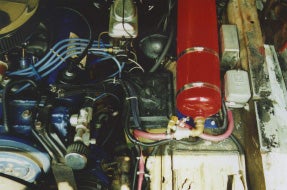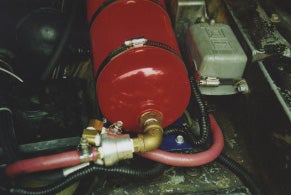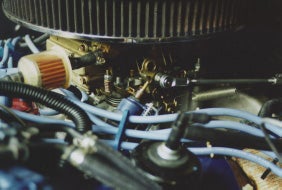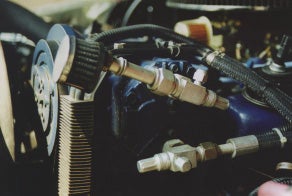78-79 Bronco A/C Compressor Conversions
A how-to article for converting your Big Bronco's air conditioner into an on-board air compressor.
In order to build a AC/Air compressor you must follow three simple principles:
- You must have a need (or at least the need to point and say "hey guys, look what I built this weekend."
- You must have more time than money.
- It helps if you have most of the parts required sitting in your shop somewhere collecting dust.
This is Erik's extremely clean compressor installation.
Note that all wires are protected
by convoluted sleeves.
The compressor it self can be mounted in a number of ways. If you currently do not run AC than the easiest and most reliable way is to use stock brackets, this is what I did. Most AC compressors are full of oil in the system for lubrication. A small amount of blow by keeps the system lubed. Of course oil in the air line for our use is not such a good thing. I've seen this handled two ways. One is to use an oil/water separator in the air line between the pump and the tank. This is what I've done and it seems to work for me. As extra insurance use a disposable paint gun type filter attached to my tire valve air chuck. That way I know no oil gets into my tires. The other solution is to drain the oil and refill with a "slik-50" type of product, run it for a while then drain it completely. The thought here is that since you'll only be running it intermittently it should still live reasonably long life. Junk yard pumps are fairly cheap, so it may be worth a try.
An old fire extenguisher can be
used as an airtank,
but a tank meant for the job would
be easier and safer.
Next decide what to use as a holding tank and decide where to mount it. While you can use a old fire extinguisher like I did, I would not recommend it. It complicates plumbing, because of a lack of inlet/outlet ports, necessitating rethread of the only port to NPT and in general probably is not as safe as a prefab tank. Since building my system I have found air tanks of suitable size for as little as $68.00 and I'll be changing mine real soon. As for mounting the tank I built a flat plate with stainless steel hose clamps as tank brackets and then bolted the plate to the left fender well. The pressure switch controls when the compressor activates and stops. I chose an adjustable one. It kicks in at 100psi and shuts off at 145psi. This is a standard 110V air compressor unit. If I were to do this again I would try and find a less bulky switch without a pressure differential between the on and off modes ie off at 145psi on at anything less. A simple on off switch controls the power to the compressor clutch and a solenoid I use to bump up the idle when ever the compressor is activated.
The small solenoid keeps the idle
speed up when the compressor clutch is engaged.
For safety you need to add a pressure relief valve rated to release at a pressure lower than whatever your tank can safely hold. Keep in mind that AC compressors have a tremendous high pressure capability. Just look at a AC manifold gauge set. To keep the intake air source clean you'll need to provide some sort of filter. My system uses a small K&N air filter mounted directly to the low side port. Again opinions vary, but this seems to work for me.
A small K&N Filter keeps the
intake air clean.
Lastly you'll need to plumb the whole mess. I strongly recommend a custom made high pressure, high heat line be made for the high side to tank connection. You can have them made to your specs at any NAPA, Diesel truck service center or hose supplier for about $15.00. I went through three "home made" supply lines before I went the custom route. The remainder of the lines and connections can be done with standard 3/8 air line and brass fittings. This is an area where you can do it cheaply (brass fittings/air line) or go hog wild and have custom lines made for every thing.




